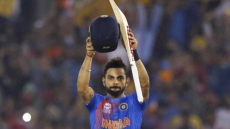KAMLOOPS, B.C. — The Winter Olympics in 2018 feel like they're coming sooner to players on the Canadian women's hockey team.
The players invited to try out for the team attempting to defend gold in Pyeongchang, South Korea, and win a fifth Olympic title in a row will be revealed a year from now.
General manager Melody Davidson and the coaching staff expected to be announced this year will have a fairly clear picture heading into the 2017 women's world hockey championship in Plymouth, Mich., of the players they want for 2018.
Those players will be named shortly after the final in Plymouth. The Canadians will start training full time for Pyeongchang in the summer of 2017.
So the 2016 women's world championship concluding Monday in Kamloops, B.C., and November's annual Four Nations Cup are significant tournaments for Canadian players. If you're not on those rosters, you're not showcasing yourself on the international stage.
"There really is only a couple more tournaments before the roster is announced," defenceman Brigette Lacquette said. "It's exciting to think about."
Lacquette, a 23-year-old from Mallard, Man., and forward Bailey Bram of Ste. Anne, Man., are on Canada's roster in Kamloops.
They were among the 27 players summoned to Calgary in 2013 to train full time in the months leading up to the 2014 Winter Olympics in Sochi, Russia.
The Canadian team's "centralization" season is a gruelling six to seven months of non-stop games, practices, dryland training and drills designed to push players to their breaking points and get them battle-ready for the Olympic Games.
Lacquette and Bram were cut from the 2014 Olympic team as the roster was whittled down to 21 players. As devastating as it was to watch their teammates head to Sochi without them, the experience jump-started both women on the road to 2018.

Lacquette made her world championship debut for Canada in 2015 and was named to the team again this year. Bram played in her first world championship in 2013, but became a regular on Canada's roster after centralization.
The chance to try again for the Olympic team fuels Bram because she was so close to wearing the Maple Leaf in 2014.
"Being released last time was tough," the 25-year-old said. "It's definitely been something I've been striving for towards. Every time I'm on the ice, every time I'm in the gym, it's kind of in the back of my mind I want to be there so bad.
"I was an alternate right up until the day they left for Sochi. I definitely use it as fuel, but at the same time I grew so much as a player throughout that year. I'm so thankful for that experience. If it happens again, I'll be over the moon."
The Canadian women play 50 to 60 games in centralized seasons, including a full schedule of games against boys in the Alberta midget triple-A league.
Lacquette had zero experience with senior women's team prior to 2014, so the fitness demands were an eye-opener for her.
"It was one of the toughest things I've ever had to go through, physically and mentally," she said. "Three years ago, I had no idea how to prepare for that. I had no clue what to expect.
"I'm very grateful I went through that because I've learned a lot, not only about the process, but of myself too as well. If I do get centralized, I'll definitely know what to expect this time around."
Canada's players in Kamloops who have yet to experience a centralized season know how important this year is to earning an invitation.

"It's always on your mind," said Jamie Lee Rattray, a forward from Ottawa. "It doesn't matter what year it is in the Olympic cycle. Once you get to this level, it's one year at a time, but you're always kind of looking ahead. You want to be at your best leading into that year.
"Every time you're on the ice, it's always in the back of my head and I'm sure for a lot of girls it's the same way."




